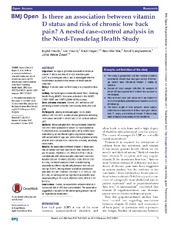| dc.contributor.author | Heuch, Ingrid | |
| dc.contributor.author | Heuch, Ivar | |
| dc.contributor.author | Hagen, Knut | |
| dc.contributor.author | Mai, Xiao-Mei | |
| dc.contributor.author | Langhammer, Arnulf | |
| dc.contributor.author | Zwart, John-Anker | |
| dc.date.accessioned | 2018-10-03T13:19:06Z | |
| dc.date.available | 2018-10-03T13:19:06Z | |
| dc.date.issued | 2017-11-25 | |
| dc.Published | Heuch I, Heuch I, Hagen K, Mai XM, Langhammer A, Zwart J. Is there an Association between vitamin D status and risk of chronic low bak pain? A nested case-Control analysis in the Nord-Trøndelag Health Study. BMJ Open. 2017;7:e018521 | eng |
| dc.identifier.issn | 2044-6055 | en_US |
| dc.identifier.uri | https://hdl.handle.net/1956/18617 | |
| dc.description.abstract | Objectives: To explore potential associations between vitamin D status and risk of chronic low back pain (LBP) in a Norwegian cohort, and to investigate whether relationships depend on the season of blood sample collection. Design: A nested case–control study in a prospective data set. Setting: The Norwegian community-based Nord-Trøndelag Health Study (HUNT). Data were collected in the HUNT2 (1995–1997) and HUNT3 (2006–2008) surveys. Main outcome measure: Chronic LBP, defined as LBP persisting at least 3 months continuously during the past year. Participants: Among individuals aged 19–55 years without LBP in HUNT2, a data set was generated including 1685 cases with LBP in HUNT3 and 3137 controls without LBP. Methods: Blood samples from the participants collected in HUNT2 were analysed for serum 25-hydroxyvitamin D (25(OH)D) level. Associations with LBP in HUNT3 were evaluated by unconditional logistic regression analysis with adjustment for age, sex, work status, physical activity at work and in leisure time, education, smoking, and body mass index. Results: No association between vitamin D status and risk of chronic LBP was found in the total data set (OR per 10 nmol/L 25(OH)D=1.01, 95% CI 0.97 to 1.06) or in individuals with blood samples collected in summer/autumn (OR per 10 nmol/L 25(OH)D=0.99, 95% CI 0.93 to 1.06). For blood samples drawn in winter/spring, associations differed significantly between women and men (p=0.004). Among women a positive association was seen (OR per 10 nmol/L 25(OH)D=1.11, 95% CI 1.02 to 1.20), but among men no significant association was observed (OR per 10 nmol/L 25(OH)D=0.90, 95% CI 0.81 to 1.01). Conclusions: Overall, no association between vitamin D status and risk of LBP was demonstrated. The association suggested in women for the winter/spring season cannot be regarded as established. | en_US |
| dc.language.iso | eng | eng |
| dc.publisher | BMJ | en_US |
| dc.rights | Attribution CC BY-NC | eng |
| dc.rights.uri | http://creativecommons.org/licenses/by-nc/4.0/ | eng |
| dc.title | Is there an Association between vitamin D status and risk of chronic low back pain? A nested case-Control analysis in the Nord-Trøndelag Health Study | en_US |
| dc.type | Peer reviewed | |
| dc.type | Journal article | |
| dc.date.updated | 2018-07-02T05:53:41Z | |
| dc.description.version | publishedVersion | en_US |
| dc.rights.holder | Copyright 2017 The Author(s) | en_US |
| dc.identifier.doi | https://doi.org/10.1136/bmjopen-2017-018521 | |
| dc.identifier.cristin | 1525405 | |
| dc.source.journal | BMJ Open | |

